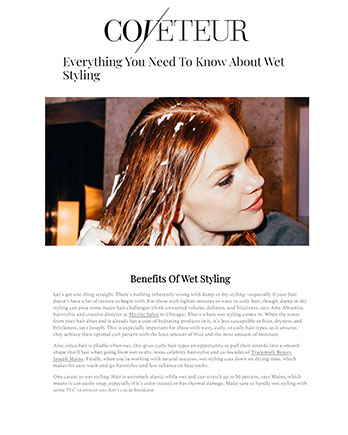Coveteur September 6th, 2021
 Coveteur
Coveteur
Hair
Everything You Need To Know About Wet Styling
Consider this your ticket to frizz-free hair.
Picture this: You've slathered on every serum, leave-in conditioner, and flyaway-fighting product, but come noon, frizzy strands still find a way to wreak havoc on your day. As it turns out, the trick to reaping the most out of your products (and avoiding the aforementioned frizziness) is to apply your hair products onto soaking wet hair—damp hair just won't cut it. According to professional hairstylist Evan Joseph, wet styling refers to applying products on hair that's so dripping wet, you can squeeze water out after applying any product. Damp styling, on the other hand, refers to when you squeeze water out before adding in stylers.
Wet styling comes with a slew of show-off-worthy hair benefits—not only does it make hair smoother, shinier, and less frizzy, but it keeps your hair nourished and healthy until the next time you wash it. Keep scrolling to learn all about this expert-approved styling method as well as how to master the art of wet styling regardless of your hair type.
Benefits Of Wet Styling
Let's get one thing straight. There's nothing inherently wrong with damp or dry styling—especially if your hair doesn't have a lot of texture to begin with. For those with tighter textures or wavy to coily hair, though, damp or dry styling can pose some major hair challenges (think unwanted volume, dullness, and frizziness, says Amy Abramite, hairstylist and creative director at Maxine Salon in Chicago). That's where wet styling comes in. When the water from your hair dries and it already has a coat of hydrating products in it, it's less susceptible to frizz, dryness, and brittleness, says Joseph. This is especially important for those with wavy, curly, or coily hair types, as it ensures they achieve their optimal curl pattern with the least amount of frizz and the most amount of moisture.
Also, since hair is pliable when wet, this gives curly hair types an opportunity to pull their strands into a smooth shape that'll last when going from wet to dry, notes celebrity hairstylist and co-founder of Trademark Beauty Joseph Maine. Finally, when you're working with natural textures, wet styling cuts down on drying time, which makes for easy wash-and-go hairstyles (and less reliance on heat tools).
One caveat to wet styling: Hair is extremely elastic while wet and can stretch up to 50 percent, says Maine, which means it can easily snap, especially if it's color treated or has thermal damage. Make sure to handle wet styling with some TLC to ensure you don't cause breakage.
Wet-Styling Straight Hair
All hair textures can benefit from the frizz-fighting benefits of wet styling, even those with straight hair. Your mane will look naturally hydrated, shinier, and smoother. Plus, wet styling can also help hold your style if you want your straight hair to hold a particular shape like a curl or bend. To avoid weighing down the hair when wet-styling straight hair, Joseph recommends using a lightweight cream immediately after the shower. Comb the product through using your fingers or a wide-tooth comb, then squeeze out the excess with a microfiber towel and let your hair air dry.
Wet-Styling Wavy Hair
When it comes to successfully wet styling wavy hair, you'll want to focus on building your texture while reducing frizz. Says Abramite, "I recommend applying a mousse from the roots to the ends and separating the waves with a wide-tooth comb. Light scrunching will also encourage volume and the wave pattern to form without frizz." But the real magic happens after you reach your desired texture: Once you're happy with your look, let your hair dry naturally and don't touch, brush, or comb it. The less you mess with the hair while it's wet, the more likely it is that it'll hold the same style once it's dried.
Wet-Styling Curly/Coily Hair
For many with curly to coily hair types, wet styling is a must—it allows the strands of each curl to gather together to form uniform texture. The result? Stunning, well-defined curls. Plus, having additional product in your hair as it dries will help the curls remain intact, shiny, and moisturized. To wet-style this hair type, Joseph recommends working in sections and adding in a hydrating lotion to each section to emphasize the coils. Then layer an oil on top to help seal the cuticle. Like wavy hair, allow your hair to air dry undisturbed, as touching, brushing, or combing through it can cause the curls to unravel.
